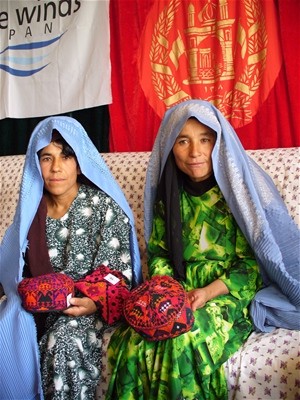Home » Reports & Data » Progress » Transforming Lives » Silk Production Revived Near Ancient Silk Road

Members of the silkworm production display their silk-embroidered products.
Kim Kim Yee: USAID/Afghanistan
265 women receive training in raising silkworms
“I am very pleased to see all of these beautiful products have been made by the women of Sari Pul,” commented Ms. Aziza Jalis, Head of the Sari Pul DOWA, “I am very proud of them.”
1 OCTOBER 2006 | SARI PUL PROVINCE
“I am very pleased to see all of these beautiful products have been made by the women of Sari Pul,” commented Ms. Aziza Jalis, Head of the Sari Pul DOWA.
Years of fighting and drought nearly destroyed the art of silk production once common in the villages of Sari Pul in Northern Afghanistan. The supply of silkworm eggs, once supplied by the Department of Agriculture, came to a sudden halt. In addition, the introduction of factory-made synthetic materials replaced the demand for silk products. Many households left Sari Pul for security reasons taking with them the knowledge of traditional silk crafts.
The women of Sari Pul Province remember how, as little girls, their mothers taught them how to care for silkworms as well as how to make hats, chapans (traditional male overcoats), and embroideries.
The ancient Silk Road once passed through Northern Afghanistan, wending its way near the great Amu Darya River, which now serves as Afghanistan’s northern boundary. As the traders passed through, they brought not only goods, but also new skills and crafts. This included the art of sericulture, the commercial breeding of silkworms for their silk.
USAID, through a grant to Peace Winds Japan, is helping to revive the craft traditionally done by women and also creating additional sources of income to Afghan families. As part of the project, the nearby Mazar Sericulture Department office and silkworm raising facilities were reconstructed. Two-hundred and sixty-five women from six villages in Sari Pul District were organized into 53 groups of five individuals. Each group received rearing kits (rearing tables, mats, plastic bins, water jugs and paraffin paper). From these individuals, eight village monitors were selected. They were responsible for monitoring the silkworm growth, training, and providing advice and suggestions to the other participants. The Mazar Sericulture Department conducted training on silkworm growing methods, with support from the World Food Program, which provided two months of food as part of the Food for Training program.
Within three months, the silk cocoon production process produced a total of 342kg of dry cocoon. Silk reeling training then commenced, turning these cocoons into silk thread. These women have begun to produce silk-embroidered products, such as hats, cushion covers, curtains, pouches and joinamaz (prayer mats). Eight months after receiving the silk worms, many hand-made silk products were displayed at an exhibition held at the Sari Pul Department of Women’s Affairs (DOWA).
“I am very pleased to see all of these beautiful products have been made by the women of Sari Pul,” commented Ms. Aziza Jalis, Head of the Sari Pul DOWA, “I am very proud of them.”







Comment
Make a general inquiry or suggest an improvement.